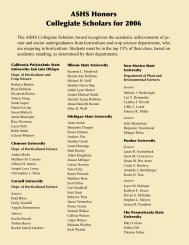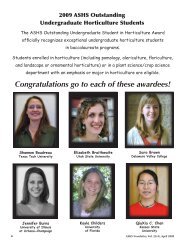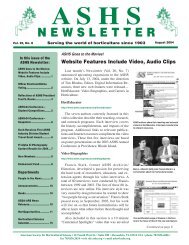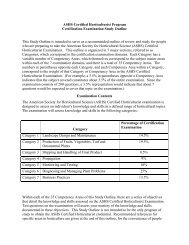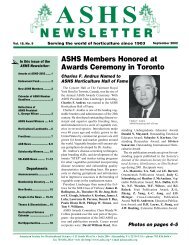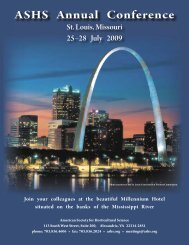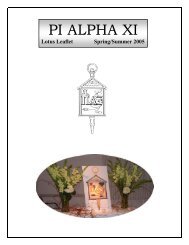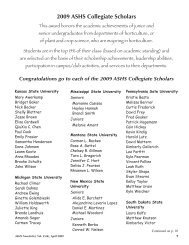N E W S L E T T E R - American Society for Horticultural Science
N E W S L E T T E R - American Society for Horticultural Science
N E W S L E T T E R - American Society for Horticultural Science
Create successful ePaper yourself
Turn your PDF publications into a flip-book with our unique Google optimized e-Paper software.
Re flec tions<br />
by Fred S. Davies<br />
ASHS President<br />
The Road to a Fellow—Sometimes it’s Full of Apples<br />
“Election as a Fellow is the highest honor that the <strong>Society</strong><br />
can award to its members <strong>for</strong> contributions to the <strong>Society</strong> and<br />
to horticulture” (ASHS Bylaws, Appendix J, IA). Most members<br />
probably would like to be recognized in this way, although I donʼt<br />
think that most members consciously pursue this goal. In fact,<br />
some members, like my old mentor, Robert Hilgeman, actually<br />
eschewed the award <strong>for</strong> years and refused to go to the awards<br />
ceremony when he was selected a Fellow in 1974. He was the<br />
George C. Scott of horticulture. Like almost every award, there<br />
is always some discussion about who should or should not be<br />
a Fellow. As my esteemed colleague, Don Maynard said, and<br />
I paraphrase, “There has rarely<br />
been a class of Fellows selected<br />
where someone wasnʼt upset or<br />
questioned someoneʼs selection or<br />
lack thereof.” Iʼve questioned some<br />
selections myself. This article will<br />
examine and discuss the Fellows<br />
nomination and award process.<br />
History and Procedure<br />
The fi rst class of Fellows was<br />
elected in 1965 and consisted of<br />
a “Whoʼs Who” of horticulture,<br />
including W.H. Chandler, V.R. Gardner, A.J. Heinicke, H.A.<br />
Rollins, and H.B. Tukey, Sr., to name a few. Itʼs diffi cult to believe<br />
that anyone opposed these selections. This class of Fellows was<br />
composed entirely of established, white males. However, the<br />
nature of our Fellowsʼ classes has gradually changed over the past<br />
40 years to include females and younger, mid-career recipients,<br />
although some of our members have expressed concern that<br />
these changes are not occurring rapidly enough. Since “Fellow”<br />
is derived from the Old English, feoh, there is no grammatically<br />
proper way, nor should there be, to distinguish between male<br />
and female recipients, as some have suggested. I hope that weʼll<br />
hold on to the term without bias in the future. In fact, I think that<br />
if there is any unintentional bias in the selection process, it is<br />
related to appointment. It appears that nominees who are primarily<br />
researchers are more likely to become Fellows than nominees in<br />
teaching, extension, or industry. The nomination <strong>for</strong>m itself is<br />
slanted toward research accomplishments. How many Fellows<br />
have had 100% teaching appointments?<br />
Qualifi cations of a Fellow<br />
The criteria and eligibility requirements of a Fellow are broadly<br />
written and include a person who “will enhance ASHS prestige<br />
and infl uence (positively) the reputation of ASHS.” The recipient<br />
should be an ASHS member <strong>for</strong> at least 10 years. The Fellows<br />
screening committee consists of nine members appointed <strong>for</strong> 3year<br />
staggered terms. Committee members must be Fellows and<br />
six of nine members must vote to approve the nominee along with<br />
75% approval by the Board of Directors (BOD).<br />
Sometimes, the procedure itself causes some controversy. But,<br />
this is true of all awards, from the Nobel Prize to the Academy<br />
Awards. For example, I often laid awake nights wondering why<br />
Sandy Koufax got elected to the Baseball Hall of Fame on the fi rst<br />
ballot (165 wins in 12 years) and Gaylord Perry did not (300+<br />
wins in over 20 years). Part of the<br />
answer was that Koufax dominated<br />
baseball <strong>for</strong> a short time, while Perry<br />
proved his value over the long run.<br />
The Perry paradigm is probably<br />
most appropriate <strong>for</strong> our situation.<br />
In ASHS, most Fellows have been<br />
members <strong>for</strong> more than 20, not 10,<br />
years and are at least 40 years old.<br />
—ASHS — Bylaws Bylaws,<br />
Appendix J, IA<br />
By comparison, the minimum age<br />
to become U.S. President is 35,<br />
and Bill Clinton was 32 when he<br />
became governor of Arkansas. My<br />
view regarding the nature of a Fellow is similar to that of Justice<br />
Steward, who, paraphrased, once said, “I donʼt know what a<br />
Fellow is, but I know one when I see him/her.” In addition, while<br />
scientifi c, teaching, extension, or industry accomplishments are<br />
important, name recognition and “value to the <strong>Society</strong>” are also<br />
important <strong>for</strong> the selection of a Fellow. Youʼll fi nd that a high<br />
percentage of Fellows have served on numerous committees, as<br />
editors, on the BOD, or as program moderators or participants at<br />
the annual meetings.<br />
“Election as a Fellow is the highest<br />
honor that the <strong>Society</strong> can award<br />
to its members <strong>for</strong> contributions<br />
to the <strong>Society</strong> and to horticulture”<br />
Fellows Screening Procedures<br />
Traditionally, the screening procedure begins with a considerable<br />
amount of time and ef<strong>for</strong>t by a sponsor who puts the package<br />
together. In most years, there is no lack of sponsor participation,<br />
which I fi nd highly laudable. However, in my opinion, the<br />
application process itself sometimes overshadows the nomineeʼs<br />
qualifi cations. I know that we need guidelines to foster uni<strong>for</strong>mity<br />
and fairness, but are we really going to disqualify a nominee because<br />
the sponsor didnʼt read the directions and submitted six letters<br />
instead of fi ve, or 16 references rather than 15? I would like to<br />
see more fl exibility related to the application itself. Nevertheless,<br />
Continued on page 4<br />
ASHS NEWSLETTER, Vol. 21(5), May 2005 3




